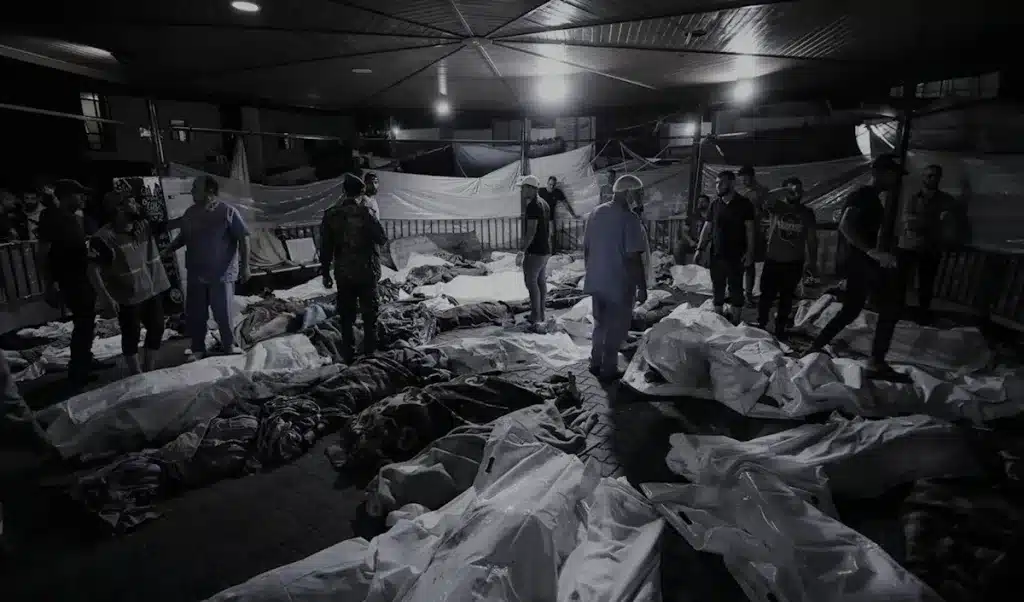
Aftermath of the Al-Ahli Baptist Hospital massacre in Gaza City, committed by the Zionist entity on October 17, 2023. Photo: AFP.

Orinoco Tribune – News and opinion pieces about Venezuela and beyond
From Venezuela and made by Venezuelan Chavistas

Aftermath of the Al-Ahli Baptist Hospital massacre in Gaza City, committed by the Zionist entity on October 17, 2023. Photo: AFP.
By Yousef Fares – Oct 7, 2025
From the earliest hours of October 7, 2023, it became clear that Gazans were about to confront an Israeli response unlike anything they had witnessed in the previous 15 years, or in the four devastating wars that preceded it. This time, there were no Israeli caveats about casualty counts, no identification of those killed, and no concern for densely populated neighborhoods when the bombs fell.
At 10:00 am on October 8, Israeli warplanes launched dozens of attacks which demolished five residential buildings at the Trans junction, one of the most crowded parts of Jabalia camp. Officials later claimed the target had been a group of captured soldiers and their abductors; the “collateral damage” was the death or injury of roughly 250 civilians and the disappearance of dozens more. That incident foreshadowed what was to follow. In past wars, large-scale killings were tied to exceptional events or substantial military objectives.
Gazans remember the major massacres of earlier conflicts: “Black Friday” in Rafah during the 2014 war, when the central market was bombed and around 100 people were killed, an attack Israeli media linked to the invocation of a military procedure known as “Hannibal” to thwart a kidnapping. They recall the massive Shujaiya massacre, when residents were trapped under intense air and artillery fire and hundreds were killed or wounded.
What changed in this war is the normalization of routine mass slaughter. By the third day of the operation, the Israeli military had shed whatever semblance of constraint or rules of engagement it had once claimed to follow. It began to resemble an organization driven by the logic of revenge, similar to “price-tag” extremist settlers, a clandestine network of far-right vigilantes formed in 2011 in the occupied West Bank who carried out hundreds of revenge attacks on Palestinians. Their actions, motivated by pure vengeance and an ideology of incendiary hatred, were about to be normalized as official state policy.
This mindset translated into a policy of bombing inhabited homes on top of their residents. In the neighborhoods of Tal al-Zaatar and al-Salateen in northern Gaza, at five in the morning the Israeli army destroyed three occupied homes. The first belonged to the Qutnani family; around 25 members of the extended family were killed: fathers, mothers, spouses, and children were among the martyrs. The same pattern was implemented east of Jabalia camp, where an entire residential block was flattened under the pretext of targeting the Hamdan family’s home. The enemy’s apparent use of extremely large bombs, whose destructive radius extended well beyond the intended single target, killed ten nearby civilians. A few dozen meters away, the Shahin family perished under the rubble of their home and dozens of surrounding houses were damaged.
That approach quickly became a daily routine. A few days after the repeated massacres of entire families, specifically on the evening of October 17, the occupation army carried out the first of its largest massacres. It struck the courtyard of the Al-Ahli Baptist Hospital in al-Zeitoun neighborhood of Gaza’s Old City with multiple munitions, killing 471 displaced civilians who had fled the eastern parts of Shujaiya and Zeitoun seeking safety.
Despite Israel attempting to deny responsibility by claiming that a locally made Palestinian rocket hit the hospital, the months that followed made clear this was merely a prelude to more atrocities. On November 31, 2023, Israeli warplanes dropped seven tons of explosive ordnance on the densely populated Sanayda neighborhood in Jabalia camp, Northern Gaza, massacring some 400 people and wounding thousands. Hundreds were listed as missing and entire families vanished from the civil registry: Abu Nasr, Abu al-Qomsan, Hijazi, Masoud, al-Bahnasawi, and Okasha among them.
During the first year of the war, such massacres became almost normalized. In that year alone, ten major massacres were recorded: the attacks on the Tal al-Zaatar and al-Fakhoura schools on November 18, 2023, which killed around 200 people; the first Kamel Adwan Hospital massacre on December 16, 2023 in Beit Lahia in North Gaza when occupation bulldozers suddenly began crushing dozens of tents sheltering hundreds of displaced people, burying them alive; the Maghazi camp massacre on the 24th of the same month which killed around 70 Palestinians after a residential block was struck.
There were also the bread-line massacres at the Nablusi junction, which killed hundreds of starving people at the start of 2024; Al-Shifa hospital massacre in late March 2024, where roughly 300 displaced people were killed; the large-scale slaughter in Nuseirat camp, where about 240 Palestinians died during an operation to free Israeli captives; the Mawasi crime on June 13, 2024, which left some 90 dead; the Tabiin mosque attack on September 10, 2024, which killed about 100 worshippers during morning prayers; and the Abu Nasr family massacre on October 29, 2024, when 270 were killed in a strike on an apartment building sheltering dozens of families during the third siege of Jabalia camp.
The occupation also introduced new instruments of killing never before used in warfare. The zionist military exerted considerable effort to produce justifications for demolishing homes and committing mass killings, for example, alleging that Mustafa Shahin, an 18-year-old, was one of the military photographers seen inside an Israeli site on October 7. The army’s early statements implied that anyone who crossed the fence or took part in any activity around the area — whether civilian or combatant, photographer or fighter — would pay with their life and the lives of their family. Later in the war, when the question “Why did they bomb them?” repeatedly echoed through Gaza after each massacre, particularly when the targets were extended families with no links to resistance or to political factions, people began to speculate about the motives.
Widely-circulating analyses suggested that in the early months of the war, the occupation had built a sprawling “target bank” using artificial and human intelligence. That list reportedly included:
Throughout the two years of the genocide, the occupation introduced new instruments of killing unlike anything seen in modern warfare. Tanks, jets, and helicopters were no longer the only agents of death. Armed quadcopter drones, remotely operated from field command rooms, were deployed to shoot, drop explosive charges, and even carry out kamikaze attacks by self-detonating among civilians. These drones quickly became Israel’s most lethal weapon. They imposed fire superiority over entire towns, making any return to homes impossible even after operations had ostensibly ended. Beyond their physical destruction, they spread psychological terror, hovering over neighborhoods, dropping bombs, and broadcasting threats and horrifying sounds throughout the night.
Explosive remote-controlled vehicles also made a first appearance during the second Jabalia invasion in early March 2024. The earliest model resembled an old M113 personnel carrier modified for remote operation and packed with at least five tons of explosives, detonated remotely in residential neighborhoods to create destruction across a 500-meter radius.
Weapons and tactics also evolved. Remote-controlled vehicles carrying tons of explosives targeted residential areas, creating destruction over hundreds of meters. Armed quadcopter drones were deployed to shoot, drop explosives, or self-detonate among civilians. These tools imposed constant psychological terror, making any return home impossible.
Two years on, the genocide continues in full view of the world. Beyond killing, the campaign has systematically degraded human dignity through forced displacement, restricted aid, and denial of medical care. Israel’s aim is clear: to render Gaza uninhabitable, forcing emigration and erasing the possibility of normal life. Yet the occupation’s plan depends on Gazans’ acquiescence and the complicity of states enabling it. Without these, the project remains incomplete.

Yousef Fares is a Palestinian reporter in Gaza. He is an author at Al-Akhbar News and he regularly posts updates on his telegram channel.